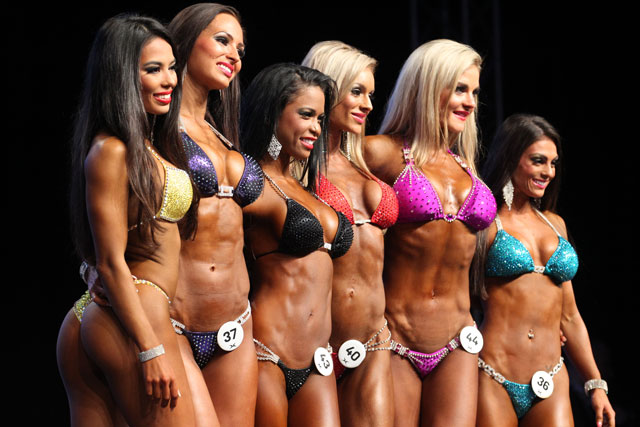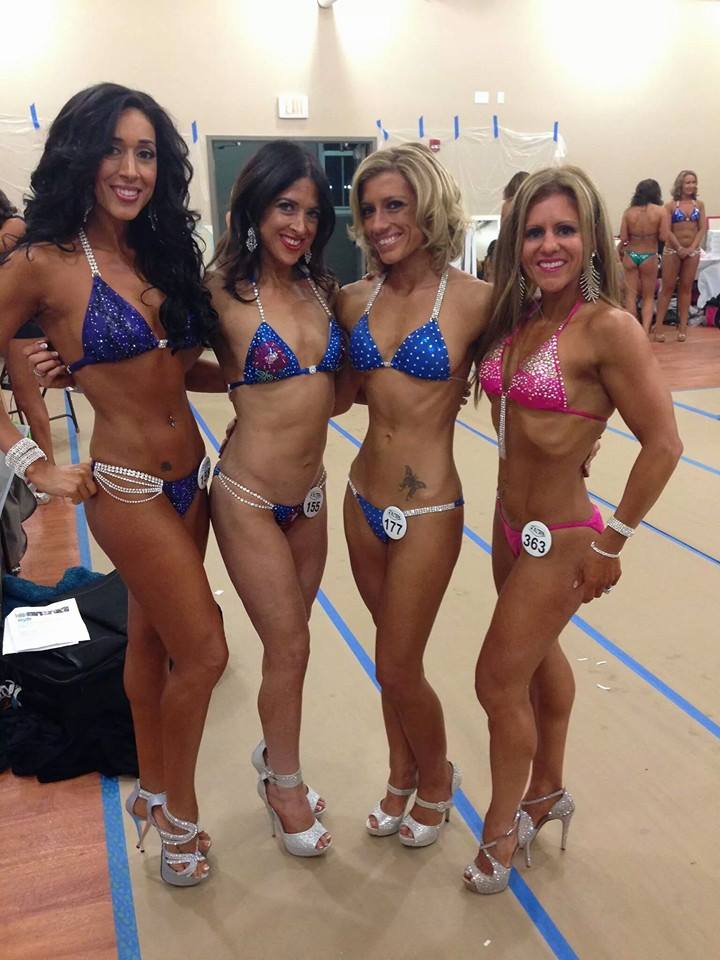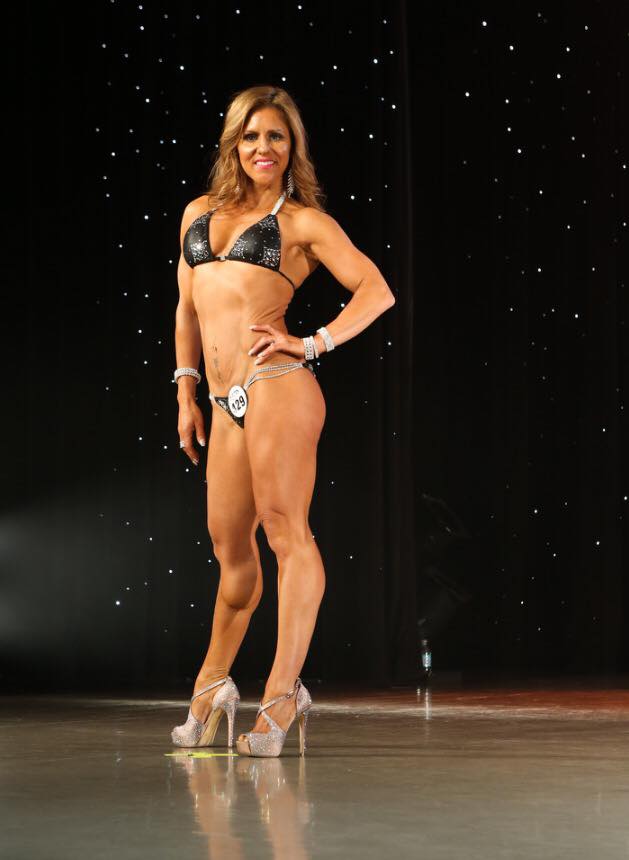
Sonia Ryan stood alongside the five other women in her category at the Fitness America show last October, sparkling in her emerald-green, sequined bikini under the bright stage lights. A little bit of that sparkle went out as she was announced last in her group, but disappointments like this have never been strong enough to get her out of the game.
Ryan, 40, a mother of four children — aged 12, 11, eight and five — is not a quitter. Of the five muscle-defining figure shows she has competed in, she’s never placed first. “Sometimes, it’s a roller coaster,” she says. “Some days, you just want to get off, but you can’t.” Ryan first became interested in bodybuilding because she wanted to feel healthier and better about herself. Competitive fitness provided her with an outlet to get out of her “mom space” and feel glamorous. She finds strength and pride in her healthier lifestyle (she’s a former smoker) — not necessarily by placing first.
Ryan is part of the growing trend of female competitive fitness (once more commonly known as bodybuilding). According to the International Federation of Bodybuilding and Fitness (IFBB), there are now over 2,000 shows and events worldwide every year; in addition, bodybuilding.com’s women’s vertical reportedly saw growth of over 150% last year. The sport itself — and its desired body types — has continued to change over time.
Today, women participate in several categories, including bikini, figure, and fitness, and each has a different set of physique goals. For bikini shows, participants are encouraged to “show shape in their arms and legs.” Wanda Tierney, chair of the IFBB Women’s Committee, says figure competitions — a category based on more muscle definition, symmetry, and balance — are gaining on bikini in terms of popularity, especially among women who have competed in bikini shows for a few years.
Daphne Espinal, 38, is one of those women. In April, she finished a two-year goal to get on stage at her first bikini competition. Coached by Malenna Saunders, formerly of the Reserve Officers’ Training Corps and Air Force (she also trains Ryan), Espinal placed second in her first show and is now working toward a more muscle-defined category for her next show.
“[Bodybuilding] started out as a bucket list [item], and I remember sharing it with someone,” Espinal recalls. That person responded by laughing at her. “That laughter, it was like, wow… I have to do this, I have somebody to prove wrong. I love how I feel now, and I’m always looking to take my body to the next level.”

Like the bodybuilders of yesterday — Eugen Sandow, Lou Ferrigno, and of course, Arnold Schwarzenegger — Ryan, Espinal (pictured), and today’s competitive fitness participants work toward a precise goal that often requires sacrifices. Fitness shows will sometimes push competitors to their limits, including restrictive diets and extreme training — similar to other physique- and weight-based sports like MMA and wrestling. And, sometimes this comes at the cost of the very thing they want to be showcasing: their health. Ryan suffered from pneumonia while preparing for one of her shows; she thinks it was likely due to a combination of increased activity and the minimal rest that comes from preparing for a show, along with trying to still make time to be a good wife and mother. She pushed on with her training anyway, insisting she knew what her body could handle.
With the growing popularity of the competitions, experts worry that there isn’t enough information being shared about potential medical issues competitors could face. The competitions’ version of an “ideal” body is often reached in too little time, explains Richard Miller, a clinical dietitian, columnist for Muscle and Fitness UK magazine, and a former competitor. “[Preparing for a show] in 12 weeks…it’s not good,” he says. The women on Saunders’ team usually complete their prep in 16 weeks, and strive to turn their regimens into permanent lifestyle changes.
To compete, both Espinal and Ryan spend, on average, two hours a day in the gym. They eat roughly six meals daily, consisting mostly of boiled, unseasoned chicken, egg whites, sweet potatoes, and legumes. They typically bring their own meals everywhere, and devote hours on Sundays to preparing food for the week. Espinal says she weighs everything she eats, and has come to see her meals not as food combinations but as specifically measured portions of proteins, fats, and carbs.

Competitors sometimes ingest more than their meals, though. Miller points to the use of supplements, protein shakes, sleep aids, creatine, testosterone boosters, fish oil, probiotics, and more. He adds to that list other possible prescription medications, painkillers, and anti-inflammatories that are used to offset the pain of intense training.
Another challenge is the off-season blues. Bodybuilders may struggle with depression post-show once their goals are met. There’s also potential for body-image disorders, such as muscle dysmorphia, which grips competitors who have an irrational fear of losing muscle. “Bigorexia,” meanwhile, is a condition where competitors perceive themselves as not muscular enough. “We know what we’re capable of, so if we’re not within five pounds of that we just feel awful,” says Ryan (pictured).
Often, that extra five pounds is tied to water weight, which many competitors force from their bodies anywhere from a few days to a week before competing. Tierney notes that she and the IFBB are trying feverishly to educate competitors about the dangers of self-dehydration.
Ryan knows other parents have judged her, and bodybuilding has been a source of tension in her marriage, but she enjoys it and doesn’t regret the stressful process she puts her body through, again and again. Espinal remembers that her first impression of the sport had her doubting her own body image and abilities, thinking she could never look like the women she saw posting pictures of themselves on social media. But now, Instagram helps keep her accountable during her prep. “It’s about figuring out what works for your body, not someone else’s,” Espinal says.
Another factor these women face is the cost associated with the glitz and glam of fitness. Popular amateur shows don’t provide cash prizes, and the expenses can add up. Ryan says she spent around $900 just on entry fees for her five shows. Add the price of coaches ($70-$200/month), supplements (over $100), and the tanning, makeup, and hair regimen for each event (over $300), and it’s an expensive industry to buy into — and that’s before you factor in the weekly grocery bills.
Still, these women are trying to pave their own path in the competition circuit. Ryan is paying it forward by coaching women on posing, an important part in placing in these shows. She wants to give others an opportunity to set a goal and build self-esteem in an industry that can “kinda mess with your mind.” “I’m proud of what I do, and I’m not ashamed of it,” she says.
Stepping on stage after essentially two years of preparation was an incredibly empowering thing for Espinal. “I’ve [received] an overwhelming response,” she said. “I get to show everyone that no matter how old you are, no matter what dream you have, if you’re focused and this is something you want to do, you just go after it.”
Courtey of: Refinery 29